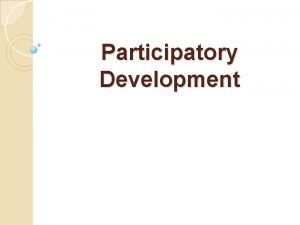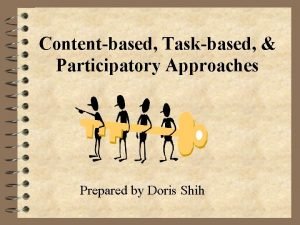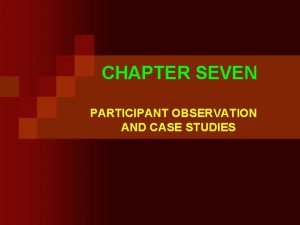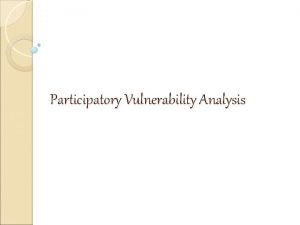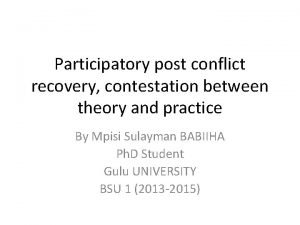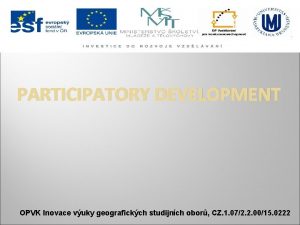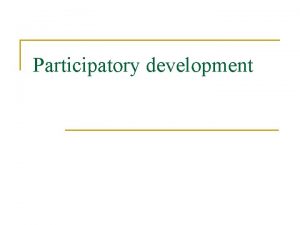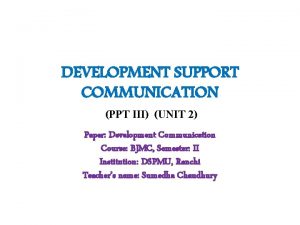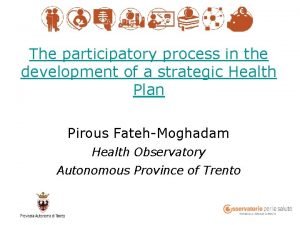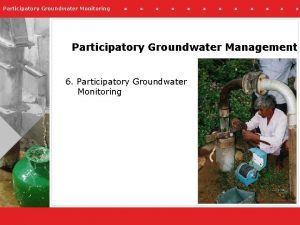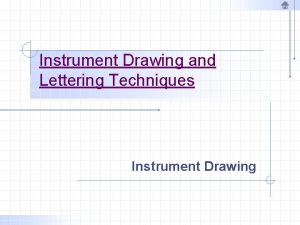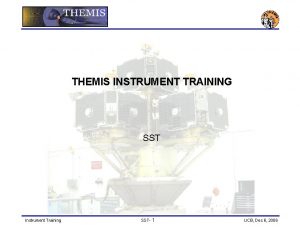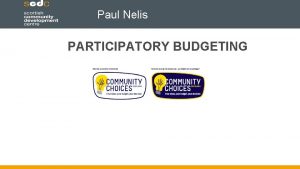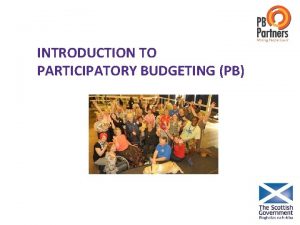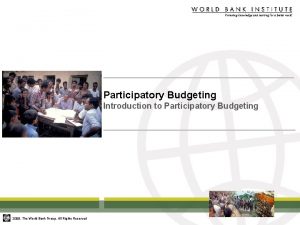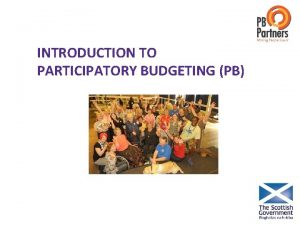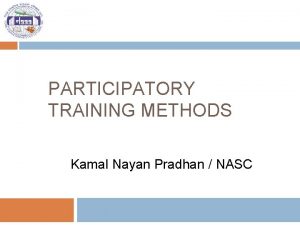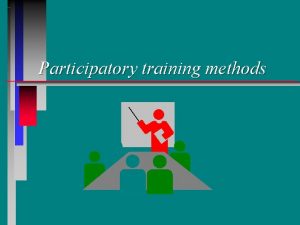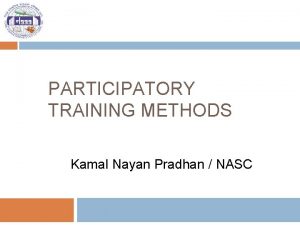Participatory Training Methods Training Methods An instrument a























- Slides: 23

Participatory Training Methods

Training Methods ● ● ● An instrument a trainer employs for delivering training content Means of communicating with participants Means to achieve certain specific objectives

Why Participatory? ● ● ● Dealing with adults Ownership to the participants Objective is to ensure learning transfer

Importance ● ● Assist in creating an Appropriate Learning Environment Enhance Participation and Involvement of the Group Give Greater Control of the Learning Process to the Participants Promote Group Interaction and Cohesion

Factors Influencing the choice of a Training Method ● ● ● Learning Objectives Characteristics of the Training Group Time Allocated Style Preferences of the Trainer Availability of Facilities and Resources

Interactive Lecture Method

Why and When to Use ● ● Large number of participants Control over the session Participants are expected to listen Facts can come alive

Why and when not to use ● ● ● Discussions of Intellectual Understanding Depends on the Personality of the Trainer Participants’ may not recall the lecture Focus can be more on effective delivery and presentation Trainers’ views can be overpowering

Case Study

Objectives ● ● Stimulate an analytical, in-depth discussion Promotes exploration and awareness of ones’ attitudes, values and patterns Helps to decide and choose appropriate course of action Greater responsibility for participants for their own learning

How to use case study? ● ● Identify the objectives of the session Based on genuine data and situations Encourage the participants to explore various alternative courses of action A case should be idealistically preceded by a theoretical discussion

Presentation and Discussion of the Case Study ● ● ● Help the participants’ understand the people and the situations in the case Build on the participants’ contributions Form a guideline so that the discussion does not deviate Understanding of the training group Refrain from expressing your own viewpoints on the issue under discussion

Limitations ● ● ● Unavailability of quality materials Artificial element Sustaining the interest of the participants’ Huge volume of information to grasp Time consuming

Role Play

What is Role Play? Active learning method � Participants act out situations under guidance of trainer � Historically, a common method in military, emergency services training but now being used in other sectors as well � Eg. Sales team engage in role-play �

Benefits of Role Play � Build Confidence � Develop Listening Skills � Creative Problem Solving � Social and Communal Approach

How to approach Role-Play Identify the Situation Add Details Assign Roles Act Out The Scenario Discuss the learning

Role Play Exercise Now let’s conduct a role-play !

Role Play Scenario Mr. Prem Pandit is an excellent young accountant working in Tradelink Corporation who is very efficient at his work. Recently, he has developed the habit of chewing tobacco which is creating nuisance in office. Tobacco is harmful for his health and the nasty smell is becoming unbearable among the colleagues. Ms. Sabeena Gurung is one of his colleagues and a good friend. They are meeting in an afternoon tea session after lunch and she plans to tell him about his bad habit and how it is

When to use Role-Play? ❏ ❏ ❏ When the topic involves person to person communication/interaction Real-life scenario that could possibly happen in professional/personal life Improve overall mood of a training session through the excitement of role-play

Challenges of Role Play � � Participants could be too shy Depend on the creativity and imagination of participants Some participants might over-act and show off so the trainer’s role is crucial Little bit time consuming

Role Play Summarized

Thank you
 Passive instrument meaning
Passive instrument meaning Methods of instrument processing
Methods of instrument processing Advantage of participatory planning approach
Advantage of participatory planning approach Qualitative research objectives
Qualitative research objectives Pra tools venn diagram
Pra tools venn diagram Participatory rural appraisal
Participatory rural appraisal Principles of pla
Principles of pla What is participatory development
What is participatory development Participatory budgeting
Participatory budgeting Participatory approach in development communication
Participatory approach in development communication Content based task based and participatory approaches
Content based task based and participatory approaches Participatory evaluation
Participatory evaluation Elite democracy example ap gov
Elite democracy example ap gov Participatory governance
Participatory governance Pros of participant observation
Pros of participant observation Pengertian participatory action research
Pengertian participatory action research Participatory vulnerability analysis
Participatory vulnerability analysis What is participatory development
What is participatory development What is participatory development
What is participatory development Participatory development
Participatory development Participatory development
Participatory development Objectives of communication ppt
Objectives of communication ppt Participatory process
Participatory process Participatory technology development
Participatory technology development







